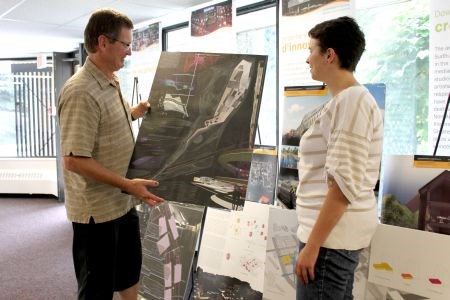Borrowing an analogy from a fellow member of the Northern Ontario School of Architecture (NOSOA) steering committee, Blaine Nicholls said the school being green-lighted is a lot like being chosen to host the Olympics: now that they have approval, the real work begins.
“There's lots of work for us now on the project,” said the committee chair. “In many ways, maybe the heavy work begins.”
In June, Laurentian University's board of governors gave the project the go-ahead, which was followed up with funding commitments totalling $36 million from the province and the City of Greater Sudbury, and a funding request pending with FedNor is expected to round out the $44 million required for the capital project.
Now the search is on for a founding director, who will lead the charge in building the faculty. The preliminary curriculum for the six-year program has already been developed and gone through the committee process, but the faculty, once hired, will have the opportunity to fine-tune it, Nicholls said.
From the outset, a goal of the school has been to revitalize the downtown, and true to its word, the steering committee is headquartered at St. Andrew's Place in the heart of the downtown core.
But plans to utilize the Market Square building, which was established as a permanent site for the city's farmers' market a decade ago, have rankled vendors and market fans. Nicholls said stakehold er consultations and a study of existing downtown buildings showed it to be the site most conducive to the school's budget and size requirement of a minimum 75,000 square feet.
“It's always been our intention to work with the market to make it a win-win situation,” Nicholls said. “One of the main objectives of the school has been downtown revitalization. Certainly with that objective, there's no intent on our part to be a bad neighbour in the downtown or come into the downtown and adversely affect an existing institution, which the farmers' market is.”
In August, the steering committee met with vendors and city council to discuss options, one of which is annexing the market and incorporating it into the design, so the school and the market would share space. At the very least, the school will retain the existing building, Nicholls said.
The prospect of designing the first architecture school in Canada in 40 years has attracted suitors of international prominence, and Nicholls anticipates selecting a design firm later this fall, with artist's renderings of what the school might look like materializing in late winter.
While the committee hasn't any preconceptions of what the building itself will look like, Nicholls said it should serve as a teaching tool, and the design firm will be asked to incorporate elements that speak to the unique character of Northern Ontario: its geography and resource-based industries, the tri-cultural character of the university, the school's bilingualism, its location in the downtown, and cutting edge design elements with respect to long-term sustainability.
While it won't necessarily be an iconic structure, Nicholls expects it will encourage students to be creative and serve as an example of “good architecture.”
Plans call for the enrollment of the first class in 2013, and, if negotiations with the city go as anticipated, the school will set up temporary digs in Market Square until the permanent building can be completed in 2015. By then, the school will have welcomed its third cohort.
Nicholls has been buoyed by the positive response to the school, and said it's already opening people's minds to change, piquing their interest in unique design, and enhancing the sense of importance of having a vibrant downtown.
“As you travel to other communities and cities globally, you bring back memories of nice downtowns,” Nicholls reasoned. “You don't bring back memories of nice suburbs.”
After a 30-year career in architecture in the North, one could understand any urge Nicholls might have to impose his own design on the school, but he remains open to letting the project evolve on its own.
“I'm seeing it unfold in a way that's tremendously encouraging,” he said. “Over my career I've been involved in a wide range of projects, and I think this project has been hugely satisfying based on the kind of support that we've got at all levels from the community, so already I am seeing the results of the project.”
This fall, the committee will ramp up its fundraising campaign to build up bursaries and scholarships, and once dates for development are firmed up, information will be made available to prospective students on how to prepare for application to the school.
The committee is aiming to bolster the experience of Northern Ontario students so they're able to compete on an equal footing with their peers, on national and international scales.




